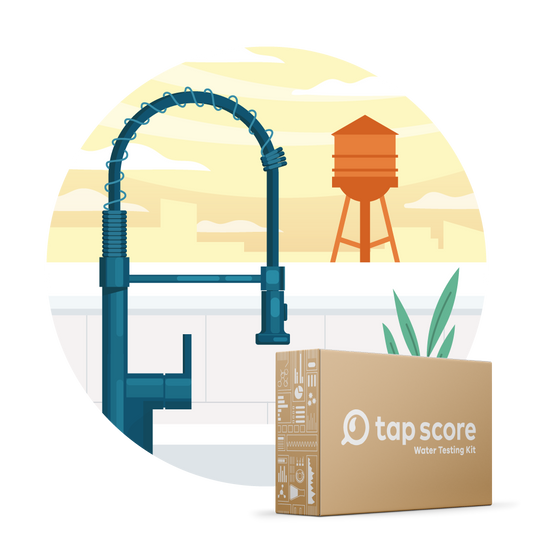
POE Versus POU Water Treatment
Our blog is written by real experts— not AI. Each guide is carefully reviewed and updated based on the latest research. Plus, with no affiliate links, you can count on unbiased insights you can trust.
When looking to treat your own water at home, understanding the differences between point-of-use (POU) or point-of-entry (POE) systems can help you find the most efficient set up to meet your needs.
POU: Point-of-use treatment systems are often installed right at the tap
POE: Point-of-entry treatment systems are installed at the main water supply line
Whether you need to disinfect your water, reduce hardness, or improve its taste, both types of devices give you a range of options for taking control of your water quality.

What’s the Difference Between POU and POE?
POU and POE are two different approaches to treating water in your home.
- POU devices are installed where the water gets used and are meant to treat water for drinking and cooking.
- POE devices are installed where water enters your home and continuously treats water for the entire building.
Both treatment styles utilize similar but often scaled-down versions of the treatment technologies deployed by water utility plant operators at centralized drinking water treatment plants.
Either style of treatment has its own advantages and can be used in combination to help tackle a variety of water quality issues. It is important to check the instructions and certification of the devices you install to make sure they are meeting safety standards.

POE: Should You Treat Water for Your Whole Home?
POE systems are the total home approach to treating the water that goes out to every tap in the building. This ensures you’re covering not just the water meant for drinking, but the water used in bathrooms and appliances like dishwashers, refrigerators, and washing machines.
POE systems are typically larger treatment units that are installed in front of your home’s water heater and can treat several thousand gallons of water per day. There are a few trade offs to consider when installing a POE system:
Pros of POE
- Convenient: POE devices are an easy way to ensure all water in your house is treated.
- Low maintenance: Their higher capacity makes them more durable and easier to maintain, with some units lasting 5-7 years before requiring a filter replacement.
- Reduced overall cost: While they can be expensive upfront, installing one POE system may ultimately be cheaper than maintaining several POU devices at every individual tap, depending on the number of taps that need treatment.
- Preserve plumbing: POE devices, like ion exchange units, are often preferred for treating hard water, which prevents scale buildup in pipes and appliances throughout the house.
Cons of POE
- Expensive: POE systems are pricey up front and generally require a specialist to install.
- Fixtures: While these devices can provide high quality water throughout your home, they may not address contaminants coming from fixtures, like lead or copper.
POU: When Is Filtering at the Tap Better?
The water you shower in doesn’t necessarily need to meet the same drinking water health targets that you want from your kitchen sink. Water you ingest is more likely to impact your health than water you bathe or shower in. By installing POU devices at individual taps you can target specific drinking water quality issues throughout your home which might otherwise be much more expensive or impractical to treat with a POE device.
POU water treatment systems are installed at a single water connection typically under the counter or at the sink where the water is being used. Examples include under-counter and countertop reverse osmosis (RO) and carbon faucet filters. There are both advantages and drawbacks to fine-tuning water quality at specific points in your home:
Pros of POU
- Water Quality: POU devices can produce high quality drinking water right at your kitchen sink.
- Accessible: They are typically compact and easy to install.
- Low cost: If you only plan to treat a few taps in your home, POU devices are cost effective to install and maintain.
Cons of POU
- Low volume: While POU-treated water can be distributed to multiple taps, their low volume production (20-100 GPD) makes these devices mostly suitable for light usage.
- High maintenance: These devices require frequent filter replacement as often as every 3-6 months, so their maintenance costs can add up.
Water Filter Type Comparison
Both POE and POU systems have their strong suits. However, it’s worth noting that a single system on its own cannot remove all contaminants. There’s no one-size-fits all approach, so identifying the needs of your home can help you choose the best system or combination of treatment options for you.
Lab-certified water testing or water treatment professionals can help you come up with a comprehensive treatment plan. Testing can also help ensure that your filters are functioning properly and removing a safe level of contaminants.
Tap Score offers a range of tests for determining your water quality needs, whether from a private well or central treatment system, as well as a guide to match you with your best treatment options based on your results.
Every Tap Score report includes unbiased treatment recommendations tailored exactly to what’s found in your water. Tap Score does not partner with or manufacture treatment products. Instead, our team of water quality engineers, chemists, and treatment experts are here to make suggestions based on your water’s unique chemistry to help you select the best filter for your home and health.










